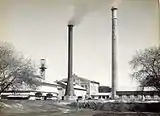Arvind (company)
Arvind Limited (formerly Arvind Mills) is a textile manufacturer and the flagship company of the Lalbhai Group. Its headquarters are in Naroda, Ahmedabad, Gujarat, India, and it has units at Santej (near Kalol). The company manufactures cotton shirting, denim, knits and bottomweight (khaki) fabrics. It has also recently ventured into technical textiles when it started Advanced Materials Division in 2011.[3] It is India's largest denim manufacturer[4]
 | |
| Type | Public (NSE, BSE: 500101) |
|---|---|
| Industry | Conglomerate |
| Founded | 1931 |
| Headquarters | Ahmedabad, India |
Key people | Sanjay Lalbhai (Chairman and Managing Director), Punit Lalbhai (Executive Director), Kulin Lalbhai (Executive Director), |
| Products | Denim, knits, woven, engineering, retail, telecom, advanced material, agribusiness, real estate, the Arvind Store |
| Revenue | ₹5,407.26 crore (US$760 million) (2016)[1] |
| ₹318.85 crore (US$45 million) (2016) | |
Number of employees | 25,620[2] |
| Parent | Arvind Lalbhai Group |
| Website | www |
Sanjaybhai Lalbhai is the current Chairman and Managing Director of Arvind and Lalbhai Group. In the early 1980s, he led the 'Reno-vision' whereby the company brought denim into the domestic market, thus starting the jeans revolution in India.[5] Today it retails its own brands like Flying Machine, Newport and Excalibur and licensed international brands like Arrow, Tommy Hilfiger, and Calvin Klein through its nationwide retail network. Arvind also runs three clothing and accessories retail chains, the Arvind Store, Unlimited and Megamart, which stocks company brands.[6][7]
History and Operations
- 1897 – Arvind Mills starts business for sarees.
- 1931 – Arvind Mills Ltd is incorporated with a share capital of ₹165,000 ($2500) in Ahmedabad. The products manufactured are dhoties, sarees, mulls, dorias, crepes, shirtings, lingerie, coatings, printed lawns and voiles cambrics, twills and gaberdine.
- 1987 – The company takes up a modernisation program to triple the production of denim cloth and to produce double yarn fabrics for exports. The new product groups identified are: indigo dyed blue denim and high-quality two-ply fabrics for exports, and products such as butta sarees, full voiles and dhoties.
- 1991 – Arvind reaches 100 million meters of denim per year, becoming the fourth-largest producer of denim in the world.
- 1992 – The company increases production of denim cloth by 23,000 tonnes per day by modernising the plant at Khatraj of Ankur Textiles.
- 1994 – The company's operations are divided into textile, telecom and garments divisions.
- 1995 – The garment division launches ready to stitch jeans pack under the brand Ruf & Tuf.
- 1997 – The marketing and distribution network of the Newport brand is strengthened and the relaunched Flying Machine and Ruggers brands were strengthened.
- Arvind Mills sets up an anti-piracy cell for the first time in India to curb large scale counterfeiting of their brands Ruf & Tuf and Newport jeans.
- Arvind Mills adopts the franchisee system for manufacturing and distribution of Ruf & Tuf jeans.
- Arvind Fashions doubles capacity at the Bangalore manufacturing facility to produce Lee jeans.
- 1998 – Arvind Mills emerges as the world's third largest manufacturer of denim.
- Arvind Mills goes live with SAP R/3 ERP package in April 1997 in their new manufacturing units.
- 2003 – For the fourth quarter, Arvind Mills saw a 280% growth in net profit.
- Arvind Mills Ltd is assigned a "P1+" rating by CRISIL, which indicates a very strong rating for their commercial paper.
- 2005 – For the fourth quarter in a row, Arvind Mills posts a profit growth in excess of 80%.
- Arvind Mills buys the entire stake in Arvind Brands from ICICI Ventures.
- 2007 – Arvind expands its presence in the retail segment by establishing MegaMart, one of India's largest value retail chains.
- 2010 – Arvind launches "Arvind Store", a concept showcasing the company's best fabrics, brands and bespoke styling and tailoring solutions under one roof.
- Arvind launches its first major real estate project.
- Arvind becomes one of India's largest producers of fire protection fabrics.
- 2012 – joint venture with PD Group, Germany, for manufacturing glass fabrics
- 2014 – joint venture with PVH Corp for Calvin Klein Businesses in India
- Launches formal suits with Goodhill Corporation Limited of Japan
- 2014 – joint venture with OG Corp, Japan, for manufacturing and sale of non-woven fabrics, the project being spearheaded by Dr. Kunal Shah
- 2014 – forays into the E-commerce segment with custom clothing brand Creyate[8]
- 2014 – The company publishes its first Sustainability Report, 'Fundamentally Right'[9]
- 2016 – The company enters online retailing with NNNow.com [10]
- 2016 – GAP joins hands with Arvind to sell apparels through NNNow.com.[11]
Gallery
 Arvind Mill in 1930s
Arvind Mill in 1930s Kasturbhai Lalbhai, the co-founder
Kasturbhai Lalbhai, the co-founder Sanjay Lalbhai, the Chairman and Managing Director of Arvind Limited
Sanjay Lalbhai, the Chairman and Managing Director of Arvind Limited
Businesses
- Fabric
- Garment exports
- Arvind Brands (owned)
- Flying Machine (company)
- Newport
- Quads
- Ruf & Tuf
- Excalibur
- ls
- Creyate
- Arvind RTW (Exclusively available at The Arvind Stores)
- Arvind Brands (licensed)
- Arrow
- Gap Inc.
- Gant U.S.A.
- Tommy Hilfiger
- EdHardy
- Izod
- Cherokee
- Mossimo
- U.S. Polo Assn.
- Nautica
- Aeropostale
- Advanced Materials Division
- EBO (exclusive brand outlet) / The Arvind Store
- Agri
- Telecommunications service provider
- Engineering
- Internet
- Real estate
- Mega Mart Retail
- Environmental Solutions
Financial restructuring
In the mid-1990s, the company undertook a massive expansion of its denim capacity even though other cotton fabrics were slowly replacing the demand for denim. The expansion plan was funded by loans from both Indian and overseas financial institutions. With the demand for denim slowing, the company found it difficult to repay the loans, resulting in an increased interest burden on the loans. In the late 1990s, the company encountered financial problems due of its debt burden, resulting in incurring significant losses.[12]
The company came up with a debt-restructuring plan for the long-term debts being taken up in February 2001. This complex financial restructuring exercise, which involved several domestic and international lenders, is considered to be the benchmark and a case study in India. The restructuring was overseen by Jayesh Shah, CFO, and advised on by a JP Morgan Hong Kong team, led by Ahmad Ayaz.
In 2018, Arvind Ltd. demerged its branded apparel and engineering business into separate entities for enhanced focus and value addition for the shareholders of the Company. It got the nod from NCLT Ahmedabad bench for demerger in Oct 2018.[13] Arvind Fashions, the branded apparel entity, will be scaling up existing brand portfolio and improve profitability across brands.[14] Anveshan Heavy Engineering, earlier known as Anup Engineering, has laid down capex plans of ₹80 crore to double existing fabrication capacity of 15,000 tonnes per annum by implementing product mix. Out of the planned investment, ₹40 crore has already been invested.[15]
See also
References
- "Arvind Ltd". BSE. Retrieved 30 July 2016.
- "Arvind Limited". arvind.com. Retrieved 20 May 2015.
- "industrial-visits | Oakbrook Business School". Retrieved 16 July 2019.
- "Arvind Mills to issue warrants to promoters". Reuters. Mumbai. 28 September 2007.
- "Working Lives India: Denim king". BBC News. 7 February 2014. Retrieved 20 May 2015.
- "Arvind Mills lines up Rs 850 cr expansion plan over 5 years". Business Line. 26 October 2010. Retrieved 27 December 2010.
- Sharma, Sanjeev; Jha, Mayur Shekhar (27 October 2007). "RIL eyes Arvind Mills' manufacturing facilities". The Economic Times. New Delhi. Retrieved 27 December 2010.
- Hegde, Prabha (19 August 2014). "Arvind Forays Into E-Commerce". Bloomberg TV India.
- "Fundamentally Right | Arvind Sustainability Report 2013-14" (PDF). Arvind. Retrieved 30 March 2019.
- Pani, Priyanka (26 May 2016). "Arvind to digitise its textile stores". The Hindu Business Line. Retrieved 13 June 2016.
- "GAP joins hands with Arvind to sell apparels through NNNow.com". The Hindu Business Line. 11 October 2016. Retrieved 10 May 2018.
- "Arvind Mills: From near bankruptcy to reinvention". The Economic Times. 14 December 2012. Archived from the original on 10 November 2013. Retrieved 10 November 2013.
- "Arvind gets NCLT's approval for demerger of branded apparel, engineering biz". The Economic Times. Bennett, Coleman & Co. Ltd. 26 October 2018. Retrieved 31 January 2019.
- "Arvind Fashions aims to double revenues to Rs 10,000 crore by 2025". CNBC TV18. TV18 Broadcast Limited. 8 January 2019. Retrieved 31 January 2019.
- Vora, Rutam (14 May 2018). "Arvind's engineering arm aims to be a full solutions provider for oil sector". The Hindu Business Line. Retrieved 31 January 2019.
